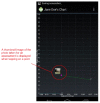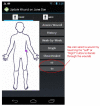A mHealth application for chronic wound care: findings of a user trial
- PMID: 24256739
- PMCID: PMC3863895
- DOI: 10.3390/ijerph10116199
A mHealth application for chronic wound care: findings of a user trial
Abstract
This paper reports on the findings of a user trial of a mHealth application for pressure ulcer (bedsore) documentation. Pressure ulcers are a leading iatrogenic cause of death in developed countries and significantly impact quality of life for those affected. Pressure ulcers will be an increasing public health concern as the population ages. Electronic information systems are being explored to improve consistency and accuracy of documentation, improve patient and caregiver experience and ultimately improve patient outcomes. A software application was developed for Android Smartphones and tablets and was trialed in a personal care home in Western Canada. The software application provides an electronic medical record for chronic wounds, replacing nurses' paper-based charting and is positioned for integration with facility's larger eHealth framework. The mHealth application offers three intended benefits over paper-based charting of chronic wounds, including: (1) the capacity for remote consultation (telehealth between facilities, practitioners, and/or remote communities), (2) data organization and analysis, including built-in alerts, automatically-generated text-based and graph-based wound histories including wound images, and (3) tutorial support for non-specialized caregivers. The user trial yielded insights regarding the software application's design and functionality in the clinical setting, and highlighted the key role of wound photographs in enhancing patient and caregiver experiences, enhancing communication between multiple healthcare professionals, and leveraging the software's telehealth capacities.
Figures








Similar articles
-
An observational study to assess an electronic point-of-care wound documentation and reporting system regarding user satisfaction and potential for improved care.Ostomy Wound Manage. 2012 Mar;58(3):46-51. Ostomy Wound Manage. 2012. PMID: 22391956 Review.
-
Wound Image Quality From a Mobile Health Tool for Home-Based Chronic Wound Management With Real-Time Quality Feedback: Randomized Feasibility Study.JMIR Mhealth Uhealth. 2021 Jul 30;9(7):e26149. doi: 10.2196/26149. JMIR Mhealth Uhealth. 2021. PMID: 34328440 Free PMC article. Clinical Trial.
-
Co-creation and evaluation of an algorithm for the development of a mobile application for wound care among new graduate nurses: A mixed methods study.Int Wound J. 2024 Oct;21(10):e70064. doi: 10.1111/iwj.70064. Int Wound J. 2024. PMID: 39353603 Free PMC article.
-
Hands-free image capture, data tagging and transfer using Google Glass: a pilot study for improved wound care management.PLoS One. 2015 Apr 22;10(4):e0121179. doi: 10.1371/journal.pone.0121179. eCollection 2015. PLoS One. 2015. PMID: 25902061 Free PMC article.
-
A Patient-Oriented App (ThessHF) to Improve Self-Care Quality in Heart Failure: From Evidence-Based Design to Pilot Study.JMIR Mhealth Uhealth. 2021 Apr 13;9(4):e24271. doi: 10.2196/24271. JMIR Mhealth Uhealth. 2021. PMID: 33847599 Free PMC article.
Cited by
-
Improving Medical Photography in a Level 1 Trauma Center by Implementing a Specialized Smartphone-Based App in Comparison to the Usage of Digital Cameras: Prospective Panel Study.JMIR Form Res. 2024 Jan 25;8:e47572. doi: 10.2196/47572. JMIR Form Res. 2024. PMID: 38271087 Free PMC article.
-
Effectiveness and safety of different dressings therapy for pressure injuries: A protocol for systematic reviews and network meta-analysis.Medicine (Baltimore). 2021 Jan 22;100(3):e23520. doi: 10.1097/MD.0000000000023520. Medicine (Baltimore). 2021. PMID: 33545930 Free PMC article.
-
Mobile Apps for Foot Measurement in Pedorthic Practice: Scoping Review.JMIR Mhealth Uhealth. 2021 Mar 4;9(3):e24202. doi: 10.2196/24202. JMIR Mhealth Uhealth. 2021. PMID: 33661124 Free PMC article.
-
Diagnostic and Prognostic Utility of Non-Invasive Multimodal Imaging in Chronic Wound Monitoring: a Systematic Review.J Med Syst. 2017 Mar;41(3):46. doi: 10.1007/s10916-016-0679-y. Epub 2017 Feb 13. J Med Syst. 2017. PMID: 28194684
-
Detection of potential drug-drug interactions for outpatients across hospitals.Int J Environ Res Public Health. 2014 Jan 27;11(2):1369-83. doi: 10.3390/ijerph110201369. Int J Environ Res Public Health. 2014. PMID: 24473112 Free PMC article.
References
-
- Pressure Ulcer Awareness and Prevention: Prevention Begins with Admission. [(accessed on 14 November 2013)]. Available online: http://www.preventpressureulcers.ca.
-
- Woodbury M.G., Houghton P.E. Prevalence of pressure ulcers in Canadian healthcare settings. Ostomy Wound Manage. 2004;50:22–38. - PubMed
Publication types
MeSH terms
LinkOut - more resources
Full Text Sources
Other Literature Sources
Medical
Molecular Biology Databases

